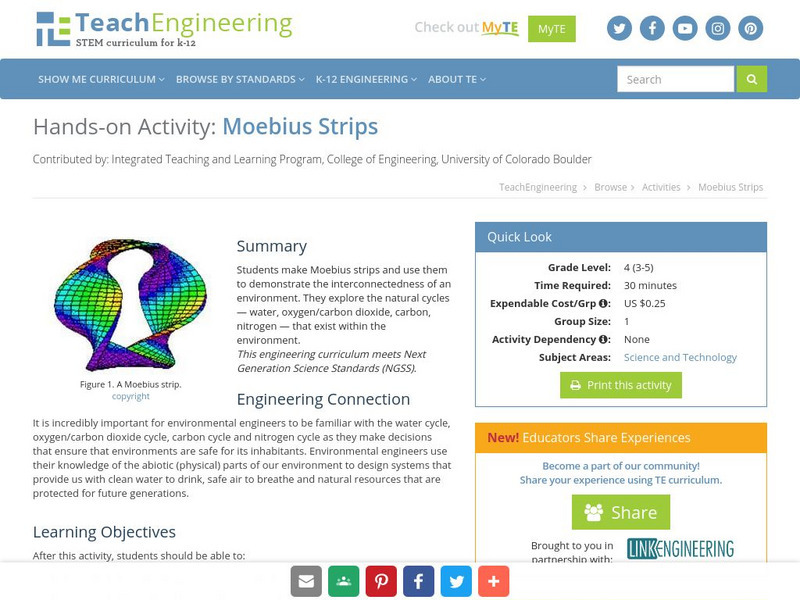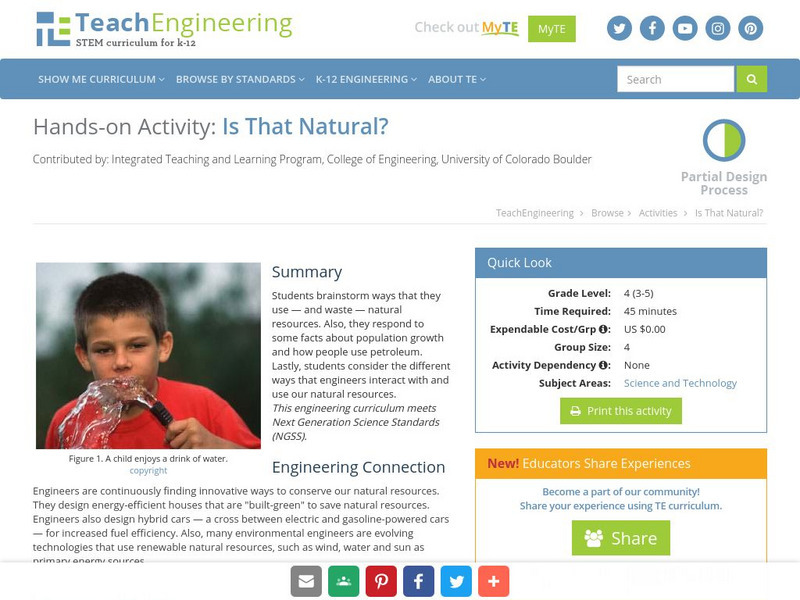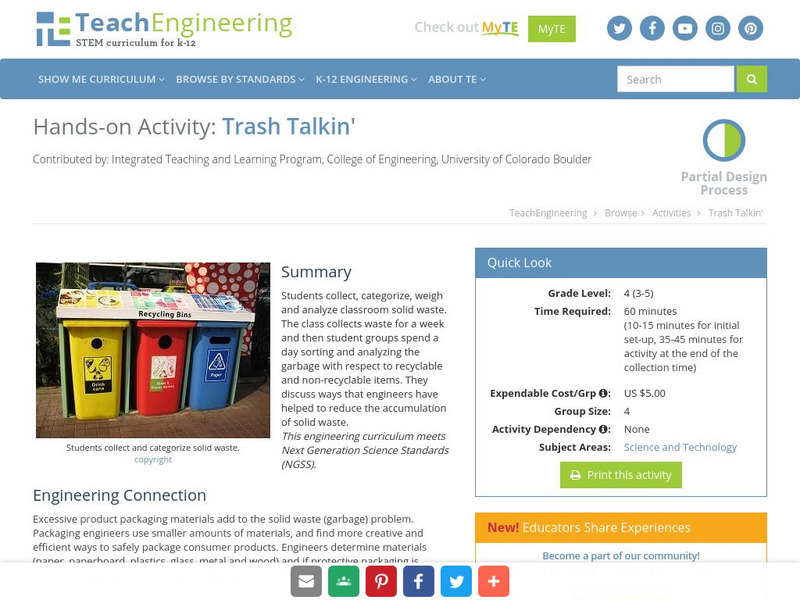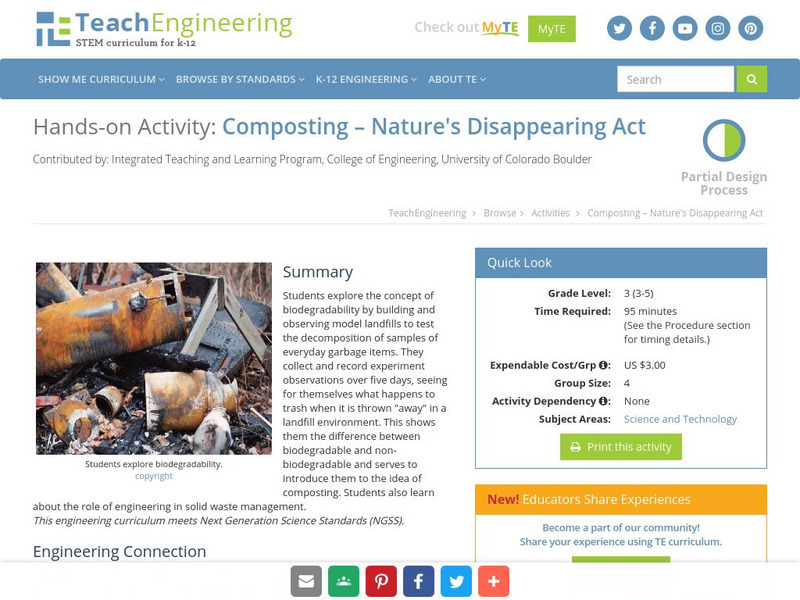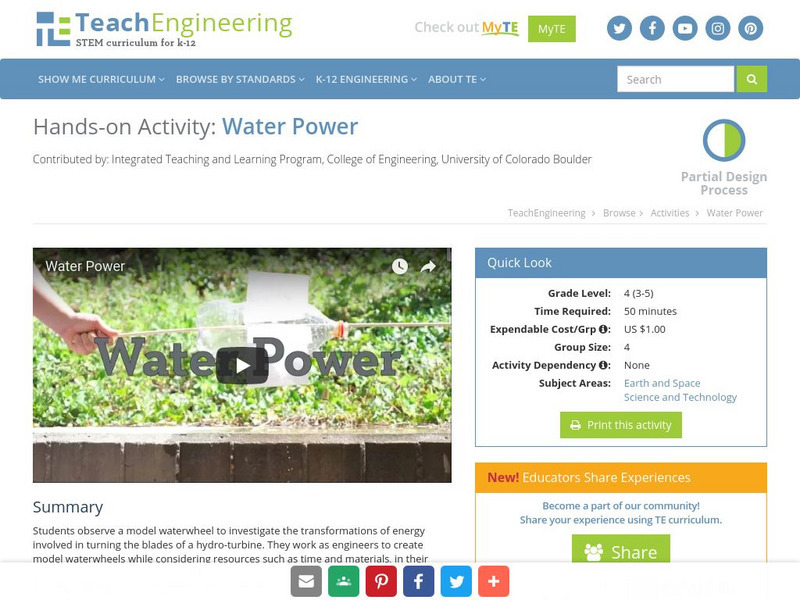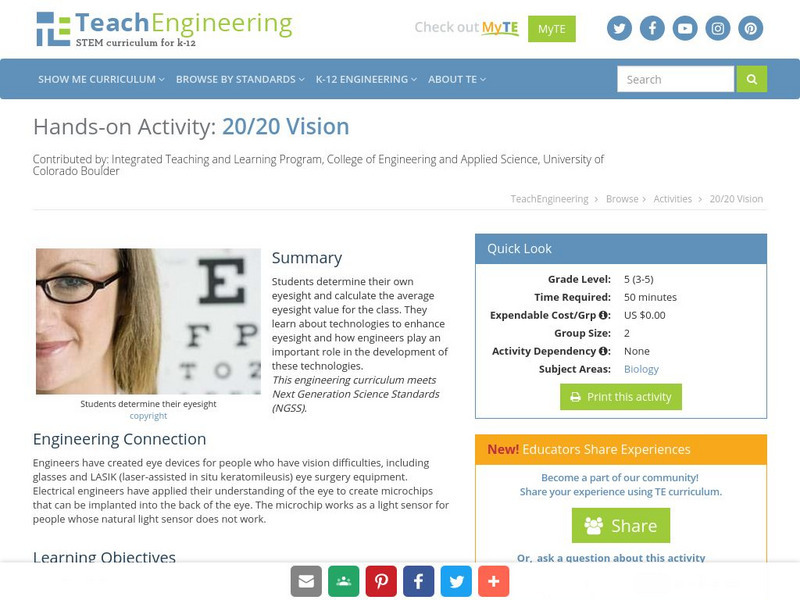TeachEngineering
Teach Engineering: From Lake to Tap
In this activity, students will use a tutorial on the U.S. Environmental Protection Agency's website to learn about how surface water is treated to make it safe to drink.
TeachEngineering
Teach Engineering: I Breathe What??
In this activity, students will capture and examine the particles to gain an appreciation of how much dust, pollen and other particulate matter is present in the air around them. Students will place "pollution detectors" at various...
TeachEngineering
Teach Engineering: Moebius Strips
In this activity, students make Moebius strips and use them to demonstrate the interconnectedness of an environment. They will explore the natural cycles (water, oxygen/carbon dioxide, carbon, nitrogen) within the environment.
TeachEngineering
Teach Engineering: Issues, Issues Everywhere
In this activity, students will learn to identify different opinions related to an issue as well as the things (information, values and beliefs) that influence those opinions. They will use an opinion spectrum to analyze the range of...
TeachEngineering
Teach Engineering: Cool Views
In this activity, students will learn the meaning of preservation and conservation and identify themselves and others as preservationists or conservationists in relation to specific environmental issues. They will understand how an...
TeachEngineering
Teach Engineering: Is That Natural?
Students will brainstorm ways that they use - and waste - natural resources. Also, they will respond to some facts about population growth and how people use petroleum. Lastly, students will consider the different ways that engineers...
TeachEngineering
Teach Engineering: The Great Divide
In this activity, students will use cookies to simulate the distribution of our nonrenewable resources (energy). Then, they will discuss how the world's growing population affects the fairness and effectiveness of this distribution of...
TeachEngineering
Teach Engineering: Trash Talkin'
In this activity, students collect, categorize, weigh and analyze classroom solid waste. The class collects waste for a week and then student groups spend a day sorting and analyzing the garbage with respect to recyclable and non...
TeachEngineering
Teach Engineering: Composting Nature's Disappearing Act
In this activity, students explore the idea of biodegradability by building and observing a model landfill. This serves as an introduction to the idea of composting. Students learn about the role of engineering in solid waste management.
TeachEngineering
Teach Engineering: Wind Power
In this activity, students develop an understanding of how engineers use wind to generate electricity. They will build a model anemometer to better understand and measure wind speed.
TeachEngineering
Teach Engineering: Water Power
In this activity, students observe a model of a waterwheel to investigate the transformations of energy involved in turning the blades of a hydro-turbine into work. Students work as engineers to create a model for a new waterwheel while...
TeachEngineering
Teach Engineering: Write On!
In this activity, students create a book, newspaper or other published work to communicate what they have learned about engineering and the environment.
TeachEngineering
Teach Engineering: Too Much Pressure!
In this activity, students learn how engineers design faucets. Students will learn about water pressure by building a simple system to model faucets and test the relationship between pressure, area and force. This is a great outdoor...
TeachEngineering
Teach Engineering: Floating and Falling Flows
Students discover fluid dynamics related to buoyancy through experimentation and optional photography. Using one set of fluids, they make light fluids rise through denser fluids. Using another set, they make dense fluids sink through a...
TeachEngineering
Teach Engineering: Density Rainbow and the Great Viscosity Race
Students explore the densities and viscosities of fluids as they create a colorful 'rainbow' using household liquids. While letting the fluids in the rainbow settle, students conduct 'The Great Viscosity Race,' another short experiment...
TeachEngineering
Teach Engineering: Hands on Activity: Designing a Thermostat
By building a basic thermostat, students will explore basic circuitry and electricity. The thermostat built out of a breadboard, temperature sensor chip, amplifier, and battery creates a linear relationship between temperature of the...
TeachEngineering
Teach Engineering: Walk, Run, Jump!
In this activity, students participate in a series of timed relay races using their skeletal muscles. The compare the movement of skeletal muscle and relate how engineers help astronauts exercise skeletal muscles in space.
TeachEngineering
Teach Engineering: Muscles, Muscles Everywhere
This activity helps students learn about the three different types of muscles and how outer space affects astronauts' muscles. They will discover how important it is for astronauts to get adequate exercise both on Earth and in outer...
TeachEngineering
Teach Engineering: Fascinating Friction!
In this activity, students use wood, wax paper and oil to investigate the importance of lubrication between materials and to understand the concept of friction. Using wax paper and oil placed between pieces of wood, the function of...
TeachEngineering
Teach Engineering: Blood Cell Basics
In this lesson students learn about the circulatory system and how it relates to engineering. Then in a hands-on activity they create a model of blood. Students also act out cholesterol in a blocked artery and look at blood cell in a...
TeachEngineering
Teach Engineering: The Beat Goes On
In this activity, students learn about their heart rate and different ways it can be measured. Students construct a simple measurement device using clay and a toothpick, and then use this device to measure their heart rate under...
TeachEngineering
Teach Engineering: Do You Have the Strength?
In this activity, students squeeze a tennis ball to demonstrate the strength of the human heart. Working in teams, they think of ways to keep the heart beating if the natural mechanism were to fail. The goal of this activity is to get...
TeachEngineering
Teach Engineering: 20/20 Vision
In this activity, students determine their own eyesight and calculate what a good average eyesight value for the class would be. Students learn about technologies to enhance eyesight and how engineers play an important role in the...
TeachEngineering
Teach Engineering: Sound Line
Students learn the decibel reading of various noises and why high-level readings damage hearing. Sound types and decibel readings are written on sheets of paper, and students arrange the sounds from the lowest to highest decibel levels....




